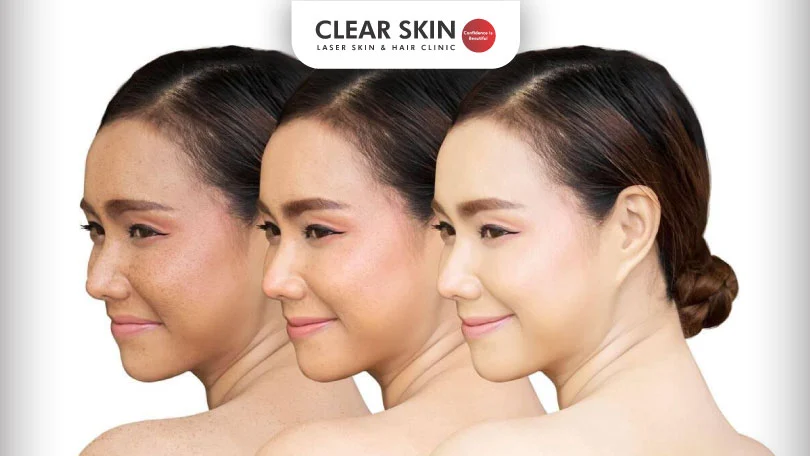Dark to Bright: Safe & Effective Skin Lightening Solutions
Reviewed By: ![]() Dr. Dhanraj Chavan
Dr. Dhanraj Chavan
Updated on: 17th March, 2025

Many people wonder if it is feasible for someone with a dark complexion to become fair. Is it feasible to change one’s skin tone forever and go beyond the limits of melanin?
In this society where the definition of beauty appears to be changing all the time, the appeal of a beautiful, fair complexion has fascinated people for years, pushing them to search for skin-lightening miracles.
Let’s explore the world of skin-whitening options and discover the reality of this alluring endeavor.
Table Of Content
- The Desire for Fair Skin
- Understanding Skin Colour: How Does your Skin get ‘Colour’?
- How Does the Skin Lightening Work?
- Medical and Cosmetic Procedures for Skin Lightening
- Glutathione Injection / Skin Whitening Injection
- Limitation and Risk involved in Skin Whitening Procedures
- Importance of Professional Dermatological Supervision
- Embracing the Natural Beauty of one’s Skin
- Conclusion
The Desire for Fair Skin
The idea that fair skin is more desirable has been a part of many cultures for a long time. In the past, lighter skin was often linked to beauty, wealth, and status. People with darker skin were usually laborers working under the sun, while those with fairer skin were seen as higher-class, staying indoors and avoiding the sun.
These old beliefs have led to the growth of a huge skin-whitening industry. Many products and treatments promise lighter skin, and despite changing beauty standards, the desire for fairer skin remains strong for many people.
Understanding Skin Colour: How does
your Skin get ‘colour’?
Before exploring skin whitening or lightening treatments, it’s essential to understand how the skin’s colouration process works. The pigment responsible for your skin tone is called melanin, produced by special cells known as melanocytes. The amount and distribution of melanin in your skin determine your unique complexion.
Melanin doesn’t just give colour to your skin—it also protects it from the harmful effects of the sun’s UV rays, acting as a natural shield.
What is Melanin and How Does It Work?
Melanin is the pigment that gives colour to your skin, hair, and eyes. It’s created through a process triggered by an enzyme called tyrosinase, which sets off a series of chemical reactions leading to melanin production.
There are two main types of melanin:
- Eumelanin: Gives skin a brown-to-black colour.
- Pheomelanin: Produces a yellow-to-red tone.
Your skin tone is determined by the unique combination and percentage of these two types of melanin.
For example:
- People with fair skin, like Caucasians, have more pheomelanin.
- Individuals with darker skin, like Indians, have more eumelanin.
Factors That Affect Skin Tone
Several factors influence your natural skin colour:
- Genetics: Your genes play the biggest role in deciding the type and amount of melanin your body produces.
- Sun Exposure: UV rays trigger melanin production, leading to tanning, which is the body’s natural way of protecting itself from sun damage.
- Hormones and Aging: Hormonal changes and the natural aging process can affect melanin production, altering your skin tone over time.
This easy-to-read guide breaks down the complex science behind skin pigmentation and highlights the key factors that determine your skin tone naturally.
What ingredients lighten skin | ClearSkin, Pune
How does the Skin Lightening work?
The goal of skin lightening also referred to as skin bleaching, is to lower the skin’s melanin content. It is primarily done by using depigmenting topical creams or lotions with active components like hydroquinone, tretinoin, and corticosteroids. These compounds block the activity of an important enzyme, Tyrosinase which is the main enzyme that produces melanin. A lighter skin tone results from reduced melanin production caused by decreased tyrosinase activity.
However, it’s crucial to remember that skin-lightening creams should only be used sparingly since they may result in skin irritation, thinning, or hypopigmentation if used incorrectly. Moreover, the result is temporary; if the patient stops the therapy or is exposed to sunlight without sufficient protection, the skin may again darken. Therefore, skin-lightening treatments must often be continued with consistent sun protection to maintain the appropriate skin tone.
Medical and Cosmetic Procedures
for Skin Lightening
Skin-lightening treatments can go beyond creams and include medical or cosmetic procedures. These procedures should only be done by a skilled dermatologist or cosmetic surgeon, as they involve more advanced techniques.
One popular method is chemical peels, where a chemical solution is applied to remove dark, pigmented layers of skin, revealing lighter skin underneath. Laser treatments are another option, using specific light wavelengths to break down melanin and reduce pigmentation.
Other skin-lightening options include cryotherapy, dermabrasion, microdermabrasion, and laser resurfacing. These treatments can give effective results but come with a higher risk of side effects. It’s very important to consult an experienced Skin Specialist In Pune before starting any procedure to ensure safety and the right approach for your skin.
Glutathione Injection / Skin Whitening Injection
Glutathione injections have grown in popularity now a days as a way to lighten skin. Because of its celebrity status, glutathione is quickly rising as a high demand treatment
It is said to work by following mechanisms :
Antioxidant characteristics: Glutathione is very strong antioxidant known to fight oxidative stress linked to aging, skin inflammation and many illnesses. Its antioxidant properties may also help in fighting the damage caused by UV rays, protecting the skin against tanning.
Enhanced skin lightening: Injectable glutathione may also provide a more even skin tone and lessen the visibility of dark spots by lowering melanin production in the skin over time.
But in addition to these possible advantages, there are important negative effects to take into account:
Lack of regulation: There is little regulation around glutathione injections used for cosmetic purposes, raising questions about the safety of the substance.
Potential health concerns: High dose glutathione have shown serious health risks, including renal damage, liver failure, and allergic responses in some reports.
Contamination risk: If an injectable medication is not given appropriately in a clinically monitored setting, there is a chance of infection and contamination which could be life threatening.
Because of the above mentioned concerns, the choice of injectable glutathione should be done after assessing its benefits to risks. It is essential that you discuss about glutathione with your dermatologist and go ahead with it only if a dermatologist recommends it.
Does Glutathione Really Whiten Skin? (क्या Glutathione सच में त्वचा को गोरा बनाता है?) | Clear Skin, Pune
Limitation and Risks involved in Skin Whitening Procedures
Procedures for skin whitening come with certain risks and restrictions, even when they provide benefits. To begin with, these treatments are often costly and time-consuming, and multiple sessions are needed to get appreciable benefits. Additionally, the result cannot be guaranteed because each person’s skin reaction is unique.
These treatments also have certain adverse reactions, including the possibility of infection, allergic reactions, scars, and skin irritation. Extreme instances of overusing skin-lightening therapies may lead to ochronosis, thickening, and rebound darkening of the treated skin. This rebound pigmentation then becomes difficult to treat and resolve.
It is also important to note that while some products and procedures may lighten skin to some extent, a significant change in skin colour is difficult to accomplish, and a complete transformation is improbable.
Furthermore, several skin-whitening products—especially those that include hydroquinone or mercury—can present significant health hazards if misused. When these compounds are taken into the body in large enough quantities, they may cause harm to organs or skin cancer.
Therefore, before pursuing skin whitening operations, people thinking about them should be fully aware of these dangers and restrictions and speak with a professional Skin Specialist Near you about them. Ultimately, it’s critical to approach skin whitening to complement rather than severely change one’s natural skin tone.
Setting Up Realistic Expectation
As previously said, getting a magical effect from skin whitening treatments is challenging. Setting reasonable expectations is essential, as is recognizing that the results may not be exactly what was anticipated. Several factors, including genetics, skin type, and lifestyle choices, may influence the success of skin-lightening procedures.
It’s also important to remember that our society’s definition of beauty should not determine one’s self-worth or need for physical modification. It’s essential to embrace and celebrate the variety of skin tones, and nobody should ever feel pressured to fit into a predetermined idea of beauty.
Lastly a healthy skin is a skin that is free of disease and that which is clear and glowing. Skin tone does not play a role in health of one’s skin. Always aim for a healthy, clear and happy skin.
Importance of Professional Dermatological Supervision
If the pursuit of lighter, brighter skin is not carried out under the guidance of a qualified dermatologist, there might be serious complications. Although they may appear affordable, do-it-yourself skin whitening procedures often employ untested or improperly applied solutions, resulting in unanticipated consequences, including serious skin responses and long-term harm.
However, the Best Skin Dermatologists have the knowledge and abilities to provide therapies according to each patient’s skin type and condition. They can carefully monitor the course of therapy, making any required modifications to optimize outcomes while reducing negative effects.
A dermatologist may also provide recommendations and advice on maintaining skin health that are supported by science. Therefore, getting expert dermatological treatment is a safer and more successful way to whiten your skin than trying dangerous do-it-yourself procedures.
Embracing the Natural Beauty of one’s Skin
Skin-lightening operations shouldn’t be a way to meet socially acceptable beauty standards. Rather, it is a personal decision that has to be taken with the appropriate perspective. Developing a healthy body image and boosting self-esteem requires appreciating and accepting one’s natural skin tone.
Additionally, skin-lightening products or procedures that gradually restore the skin’s natural tone might provide a more subdued and invisible effect. This method also helps people recognise the distinct beauty of their skin and prevents any problems.
Do You Know?
Roughly 250 Patients Are Treated
Everyday By These Dermatologists
(You are one click away from flawless skin)
Meet Our Dermatologist!
Conclusion
Even though some people may want lighter skin, it’s important to undertake the process carefully and under the advice of a specialist. Ultimately, genuine confidence and self-acceptance come from loving oneself and appreciating natural beauty in all its manifestations.
By encouraging a positive and health-conscious approach to skin lightening, we can enable people to make decisions that put their wellbeing and value first. So let’s appreciate diversity in all its forms and enjoy the beauty of our natural world! One small step at a time, let’s defy social conventions and reinvent what beauty looks like.
Further Reading
Home Remedies for Acne Scars
Effective Home Remedies for Acne Scars
Salicylic Acid: Your Ultimate Guide to Banishing Acne Scars
Salicylic acid helps fade acne scars by exfoliating the skin and promoting cell renewal. Discover its benefits, effectiveness, and how to use it safely.
चेहऱ्यावरील मुरूम व पुळ्या जाण्यासाठी काय उपाय करावे?
मुरुम आणि पॉकमार्क्स कमी करण्यासाठी घरगुती उपाय शोधत आहात? नैसर्गिक घटकांसह सोपे आणि प्रभावी उपचार जाणून घ्या स्वच्छ आणि आरोग्यदायी त्वचेसाठी.
17 Home Remedies to End Your Acne Woes!
Clear your acne naturally with simple home remedies! Discover how aloe vera, green tea, and turmeric can help soothe and heal your skin.
Have thoughts? Please let us know
We are committed not only to treating you, but also educating you.






